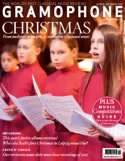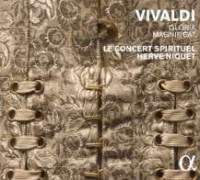Texte paru dans: / Appeared in: |
|
|
Outil de traduction (Très approximatif) |
|
|
Interview:
Vivaldi’s
Gloria
I’m sitting in the impossibly elegant 19th-century apartment in the centre of Paris’s 2nd arrondissement that Baroque ensemble Le Concert Spirituel call their home. Across the table from me, somewhere between polished parquet floor and moulded cornicing, Artistic Director Hervé Niquet is impersonating a chicken. In fact, he’s impersonating two.
‘Bwaagh, bwaagh bwaagh, bwaaaaagh…’ There’s a pause and a look of expressive, Gallic horror. ‘I find it so difficult now to listen to this piece with just two soloists as it’s usually done,’ Niquet explains. ‘I really do feel like I’m listening to two hens squawking at one another.’
The music in question is the ‘Laudamus te’ from Vivaldi’s Gloria, RV589, one of several solo movements rendered oddly unfamiliar in Niquet’s new recording, which shuns the now-traditional SATB forces in favour of Vivaldi’s original version for women’s voices. Solo movements – even the delicate ‘Domine Deus’ – become unison affairs, sung by up to 12 voices, while contrapuntal sections take on new and startling melodies, as ‘tenors’ jostle with sopranos for the melodic line.
‘Everybody knows this piece,’ says Niquet, ‘and I wanted to find another angle on it. After we first performed this version there was a real sense of wonder and surprise among the audience: they had discovered something new in a very familiar work. The piece is completely transformed – you hear your memories of it but don’t recognise what you are hearing, it’s a sensual surprise.’
The biggest surprise of all, however, after hearing Niquet’s performance is to take a look at the score of this original version and realise that – in fact – nothing has changed. Vivaldi adjusted none of the part-writing in adapting the work for mixed singers, merely restoring the bass and tenor lines to their original octave and allowing contrapuntal chance to do the rest. So why bother making the edition at all?
‘The version for mixed voices was produced by Vivaldi for purely commercial reasons – just as he did with his Magnificat and many other motets. When you compose music for a nunnery or, in this case an all-female orphanage – Venice’s Ospedale della Pietà – you have no men, but you still want to have four vocal parts, so you make do with what you have. It’s pragmatic – if you don’t have any singers you get the flute to play the soprano part. People still understand that it’s the ‘Kyrie’.”
Niquet himself, inspired by the pragmatism of Vivaldi and his contemporaries, has made some changes of his own, swapping the solo oboe and trumpet of the original – a texture synonymous with Venice, where it became the signature for music of St Mark’s – for strings, further intensifying the heady, high harmonics of this version.
‘In sections like the “Propter magnam gloriam”, wherever you’re used to hearing an interval of a ninth in mixed-voices it becomes a second. The speed of vibration becomes much faster, there’s a much greater sense of harmonic tension, of excitement. It’s the reason so many men came to listen to the all-female choir of the Pietà: the sound was just so sexy. That’s true throughout, but especially in the four-part writing.’
Philosopher Jean-Jacques Rousseau was just one of the many men fascinated by the Pietà choir, lamenting the ‘accursed grills’ that permitted him to hear, but not see, the singers. Sneaking his way in one day he was, however, horrified to discover that ‘scarcely one was without some considerable blemish’ – an object lesson in drawing back art’s veil of illusion. But it was an illusion consciously and deliberately fostered by the orphanage, whose musical achievements were essential to its survival.
‘The reason that every church in Europe contracted the finest composers to write for them was pretty cynical. It was so that everyone in the town knew that, at this particular church, you could hear the best music available, for free. But of course afterwards there would be a collection…’ It was with one eye to such concerns that Vivaldi was encouraged to fulfil the role of interim choirmaster at the Pietà from 1713 to 1717, contracted to compose a daunting number of new works each year for the 70-strong Coro, which in 1715 included not only the Gloria but also, ‘a complete Mass, a Vespers, an oratorio, over 30 motets and other labours’. With the female tenors and basses singing up the octave while instrumental bass parts (organ, cellos, double basses) remain at pitch, this all-female Gloria achieves unusual resonance and architectural clarity owing to its doubled octaves. For Niquet, this can only be a good thing. ‘The sin of parallel octaves is the invention of the 19th century. Yes, it’s prudent not to write octaves in different parts, but it can be so effective dramatically – it has real strength. Think of organ music, of the impact of the 16ft. Here it’s even richer: we have 16ft, 8ft and 4ft in the texture. The harmonics of this female ensemble are very high, so if you don’t have a properly grounded bassline it all gets too nasal. Plus there’s the additional harmonic drama. Every modulation, every shift of tonic, doubled at the octave, feels like a much bigger distance and a more extreme gesture.’
No movement is more startling, more unexpected in its harmonic drama than the ‘Et in terra pax’. After the rollicking semiquaver jollity of the opening, this ‘peace on earth’ feels like a cruel musical joke – a tentative, fearful peace denied its resolution by restless chromaticism. It’s perhaps this music that prompted musicologist Alfredo Casella, who
‘This is a prayer from a community, some of whom would spend their entire lives enclosed, behind a screen’ – Hervé Niquet masterminded the first modern performance of the Gloria in 1939 after the rediscovery of the manuscript, to comment on the work’s ‘profound sadness’. For Niquet it’s a reflection of the work’s birthplace.
‘What is the first thing that strikes you about Venice? Water – water you think is quiet and still but which never is. It’s the illusion of calm, always unsettled, always moving. The text of the “Et in terra pax” might be all about peace but it’s a distinctively Venetian peace. In the original SSAA version, the chromatic movement is ratcheted up that much more tightly. The melodic call and response both happen at the same octave and is that much more emphatic, more unnerving.
‘For me it’s actually now strange to hear the SATB version – I find it so poor, so unsatisfying in comparison. It’s twodimensional, flat, whereas the SSAA Gloria is threedimensional – it’s alive.”
But for all the Gloria’s quasi-operatic scale of gesture and musical effect, Niquet is keen to stress that, for him, this concert-hall staple is not a concert work. ‘This is a prayer from a community, some of whom would spend their entire lives enclosed, behind a screen. You need to understand the experience of these women and young girls. It’s not enough just to recreate their original sound, you have to also capture their collective emotion in this music.’ |
|
|
|
|
|
Cliquez l'un ou l'autre
bouton pour découvrir bien d'autres critiques de CD |
|




